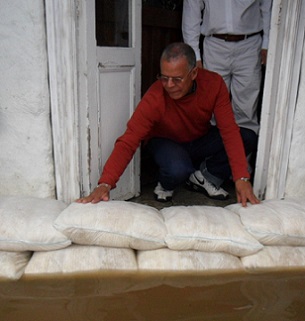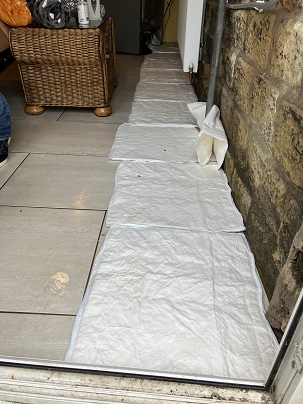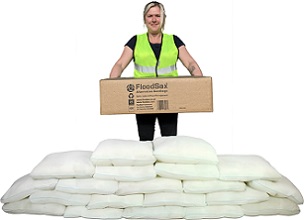 Filthy floodwater inside a kitchen
Filthy floodwater inside a kitchen
 FloodSax sandless sandbags protecting a home from contaminated floodwater
FloodSax sandless sandbags protecting a home from contaminated floodwater
 FloodSax alternative sandbags soaking up floodwater dripping down the walls from a leaking roof
FloodSax alternative sandbags soaking up floodwater dripping down the walls from a leaking roof
 All these 20 FloodSax sandless sandbags came from this one easy-to-carry box
All these 20 FloodSax sandless sandbags came from this one easy-to-carry box
More than 6 million properties at risk of flooding just in England … but local councils have absolutely no responsibility to provide sandbags in an emergency
More than 6 million properties are now at risk of flooding in England ... but councils don’t have to provide sandbags or any other flood prevention measures.
The stark figures released by the Environment Agency means that roughly one in five homes are potentially vulnerable to flooding from rivers, surface water or the sea with 122,000 properties deemed to be at high risk.
Many people are shocked to learn that local authorities have no responsibility to protect them from flooding and with many council budgets now in dire straits they have no money for anything that’s non-statutory so people must protect their own homes and businesses.
Flooding also comes at a massive cost to the insurance industry.
The average cost per claim for a flooded house is £32,000 and £83,000 for small and medium businesses. Flooding is so catastrophic that 40% of businesses never open again following a flood.
This is on top of new statistics released by insurance comparison website Confused.com which show that the cost of damage caused by flooding in the UK has increased by well over 200% in just five years.
The worst hit areas are London and Liverpool with London’s flooding risk increasing by 37.5% in 5 years and the number of properties in Merseyside in danger of flooding soaring by 300% since 2018.
At the end of 2023, London had the highest number of ‘high risk’ homes with 11,443, followed by Devon with 8,992 and Lincolnshire with 8,320. Thousands more homes in all these areas are also at risk of flooding but the risk is deemed to be lower.
Amazingly, one in four UK homeowners or renters live, or have lived, in a flood risk area and 28% of them have suffered flooding damage to their property.
There are many reasons why the number of homes at risk of flooding has increased over the years.
Climate change is a contributing factor, leading to more rainfall and rising water levels, but more homes are being built each year, some of them on flood plains or land that’s close to water such as rivers and streams which could burst their banks.
Being flooded takes a heavy toll on people financially, physically and mentally with many forced out of their homes for months while they are drying out and being repaired.
Matthew Harwood, home insurance expert at Confused.com, said: “Flooding is something that affects the UK every year, from severe rainfall to flash flooding. The impact that this is having on homes and communities across the country can be devastating. It’s concerning to see that people are having to recover more from their insurers today than compared to 5 years ago.
“It’s not only the financial impact that’s affecting people. The emotional impact of flood damage can be extremely distressing. In some cases homes become unliveable, with more than a third of those affected having to move out.”
Far too many people still do nothing to protect themselves from flooding and are even unaware of the flood risks in their area.
Many wrongly believe that local councils will provide sandbags and other flood mitigation measures but this is simply not the case as local authorities have absolutely no responsibility to provide any flood protection. It’s a total myth they will provide sandbags in a flooding emergency.
As the Environment Agency continually stresses, it’s down to every homeowner, landlord, renter or business to organise their own flood protection.
The Environment Agency states: “Don’t assume the authorities will provide you with sand bags in a flood emergency. It’s the responsibility of property owners to take appropriate action to protect their property from flooding. Sandbags are relatively ineffective when compared to purpose-built flood protection products. We strongly encourage people to use these products.”
Many now use FloodSax alternative sandbags which are way more multi-purpose, flexible and cost-effective than old-style sandbags, space-saving to store and quick and easy to deploy.
In their dry state, FloodSax are very flat with a large surface area so are ideal to soak up leaks, drips, spills and floods such as beneath sinks, below boilers and even underneath pipes under floorboards. FloodSax will also absorb water leaking in through roofs and windows.
To transform FloodSax into instant sandbags, simply immerse them fully in water and the gelling polymer inside the FloodSax absorbs and retains the water, transforming the FloodSax into an instant sandless sandbag which is a uniform shape so they are easy to handle and stack.
For more information on FloodSax go to www.floodsax.co.uk
To see if your home or business is at a high risk of flooding go to Check your home’s flood risk in England - Confused.com
For more information on the Flood Re scheme which helps people in high risk flood areas go to Flood Re - A flood re-insurance scheme